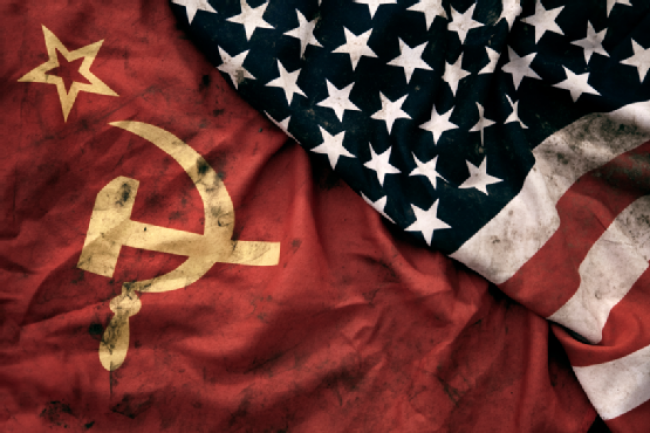Once the regimes of the ex-Soviet Union in Eastern Europe imploded we had a geostrategic change in American and European capitalism towards unconstrained capitalism.
Prior to this turn, the coal industry, aeroplanes and public services, and major utilities like electricity, gas, water, telecoms and the banks used to place the needs of the people first in terms of employment and infrastructure development. National defence has been jeopardized. For example, in Greece, all the military production factories were shut down. A similar process happened in ex-Yugoslavia.
Why did America survive the 1929 Wall Street Crash?
As everyone knows, the American collapse of the 1930’s wasn’t erased by Roosevelt’s New Deal but by the re-militarisation of America for World War II. The collapse of the European powers and the rise of the Soviet Union ensured a new role for America based on the global reserve role of the US dollar via the financial and economic agreements made in Bretton Woods, World Bank, the IMF and NATO initially, and with GATT, the WTO and the latest version of TTIP in our times.
The hegemonic power of the USA under the pressure of the Soviet Union and its various satellites was forced to maintain its main strategic businesses under serious government regulation. In sectors like natural gas or oil, the US government imposed a different price for each area, for each social class and for every user. Europe followed suit.
In Japan and South Korea, Singapore, Taiwan and Hong Kong – in the so-called Asian tigers – the industries had private shareholders but industries were subsidised and directed by the state.
As long as the Soviet Union existed, inflationary currency went to the market and consumption and employment were maintained. After the fall of the USSR with capitalism not being frightened by the threat of communism (as they envisioned of course) the unconstrained lust for profit emerged. In almost every country they imported a black market in labour in order to save sagging profits –caused due to the crisis of capitalism since the 1970s in what is known as the falling rate of profit as the oversupply of goods causes prices to drop and results in less profit for companies- without even for a second thinking who would consume all these produced goods. Thus, we have an endless and perpetual cycle of unemployment and underconsumption which produces, even more, unemployment. We also have jobless recoveries as companies during recession fire workers, rely on advanced technologies instead and see profits grow while unemployment increases with no one to consume the goods.
In the 1980’s the Soviet Union passed via the last stage of disintegration. Internally the ruling nomenklatura (Soviet bureaucrat) had to confront the intense oppositional activity of people like A. Zakharov (a famous scientist and creator of the Soviet Hydrogen bomb).
During the same period, the USSR ended up getting caught in a war of attrition with the Mujahideen guerrillas in Afghanistan, who were supported by the USA and Saudi Arabia, Pakistan and other Muslim states. In February 1989, the Soviet army was forced to abandon Afghanistan. This was the era when the Soviet Union was transformed into a miserable wreck. No one on the planet was frightened of the corrupted bureaucrats in the Kremlin. The capitalist restoration took the form of hybrid state capitalism. This also followed in China.
Thus, we entered the path of unconstrained capitalism and, unfortunately, we are at a stage of productive development where we can all automatically be led to a full blown economic collapse. In the 1990s, initially starting from the USA, the bosses after 60 years of practice, abandoned the mild practice of pensioning people off (if not with state pension) with mass and sudden sackings. They hired cheaper workers in Asia instead.[i] Industrial enterprises that could sustain whole communities started to close one after the other without warning. Western bosses felt unconstrained. They had no fear to shut down their industries and relocate to Asia and do as they saw fit. No one would stand up for the western workers and the workers themselves were ashamed of being fired. The sacked workers lost more things that just their work. They saw their lives getting shorter due to anxiety and stress whilst their mortgaged homes were repossessed. The closure of Detroit – which in 1950 was the third richest in terms of workers’ income city in the USA – is a specific example for this. The closure of Britain’s coal industry in the 1990’s is another.
With the collapse of the soviet regime, the West, starting from the end of the 1980’s, started the gradual reduction of state intervention in the economy. While workers demanded 30% wage increases in the 1970s to keep up with inflation, the priority of the government was attacking inflation head on while keeping wages stagnant. The1980s saw mass unemployment plus low inflation.
Whilst in 1945 at Bretton Woods the value of the dollar with gold was agreed at $35 an ounce, in 2012 due to the unregulated printing of dollars for the financing of consumption, an ounce of gold almost reached $2,000!
Modern technologies aim to make reductions in the numbers of workers to lower the costs of production. This advantage exists only in the short term: only as long as this technology remains for the sole use of a few and this is impossible. Other competitors jump on the bandwagon.
The result of having a surplus of workers and a collapse in profits is taking steps to utilize the surplus profit produced by the remaining workers. That is why companies trying to defend their profit rates are turning themselves to cheaply imported labour from abroad or they relocate to Asia, usually China for cheap labour. These are the twin sides of the same corporate coin.
From 1945 to 1990 capitalism was controlled by the state and in this period the peoples of Europe, the USA and Japan – even in Greece – could stay booming. But after the collapse of the west’s competitor, the Soviet Union, all this changed: privatisation, deregulation, globalization, disconnection from the fate of employees, tight border controls abolished, low taxation of corporations, the privatization of all public services: universities, prisons, schools and old people’s homes – all with the aim of more and more profit. They had nothing to stop them.
China enters world market and inaugurates Globalisation
After Nixon’s visit to China in 1972, Mao’s death in 1976 and the end of the cultural revolution, Deng Xiaoping and the new Chinese leadership took reforms in the economy while the movement towards a mixed economy under the leadership of the party began. The collectivization of land was abolished with the aim being the ‘increase in productivity’. In 1978, China started to renew its diplomatic relationships with Japan which ended up being a significant foreign backer. Current China is characterized by an economy of socialist character but of state capitalist essence with a section being private. Russia has gone down the same path.[ii]
The difference between the current capitalism and the capitalism of the 19-20th century, i.e. capitalism until roughly 1990, was that the banks and the capitalist economy are now unregulated. Before, they were controlled to an extent by the state.
Initially, the control of the banks by the state was maintained by tradition, but in the 20th century capitalism passed into a new imperialist stage and state control was imposed by the conflict between the Big Powers and the conquest of colonies. World War I led to the militarisation of national economies of the European powers. The same happened in World War II. The existence of the Soviet Union, China, North Korea, Vietnam, Cuba and the threat of communism resulted in the west continuing state control of capitalist economies even after the war was over.
Collapse of Soviet Union
The state capitalist tendency started to be loosened gradually with the onset of the crisis in the camp of the Eastern block. This took place initially with the rebellion in Eastern Berlin in 1953, later in Czechoslovakia and Poland, whilst in the meantime, there was the open internal opposition in Russia. Gorbachev’s rise in 1985 signaled the beginning of the end of the Soviet regime. The final nail in the coffin was given by Russia’s defeat in Afghanistan which indicated that the Soviet Union was on the verge of disintegration (ironically America is suffering now in the same country during a similar juncture in its own history).
No one was any longer frightened by the USSR in the late 1980s. The ‘reformer’ Gorbachev in a meeting with Reagan made a common declaration about the end of the arms race and the end of the Cold War despite it having ended in practice, at least, a decade earlier. The road was now open for removing state control in the economies of the West and in Greece with the arrival of unconstrained capitalism. The Greek collapse was imposed by Samaras’ New Democracy government with the mass sackings of 1.5m workers – at a time when we already had 700,000 unemployed.
This is what happened. Once the Soviet Union collapsed and the other regimes in Eastern Europe collapsed the imperialists believed that the field was open to them, that neoliberalism had arrived. Everything and all would be subsumed by our new infallible God: private ownership.
This implied that the 1973 crisis whose full effects were hidden for a couple of decades in the shadows of capitalism would now go mainstream and rise openly to the surface with an oft-repeated catchphrase of TINA –there is no alternative.
Left degenerates into an appendage of Capitalism in collapse
What was the position of the traditional Left in confronting all these explosive changes which occurred? The total and absolute adaptation, the total subservience to imperialist demands. Its middle-class leaders, not only abandoned even the immediate reformist demands of the working class but participated as open servants (like bourgeois politicians!) in the imperialist propaganda supporting it without any preconditions. One can see in a whole host of political positions how far they have degenerated in particular with the most openly reactionary positions on (illegal) migration, their nonsense regarding ‘racism’, ‘islamophobia,’ ‘homophobia’ (the latest version is ‘transphobia’), ‘populism’, ‘nationalism’, the total adulation of the European Union and the Eurozone, and their blanket cover for the full brunt of US imperialist attacks against Yugoslavia, Iraq and Afghanistan, giving underhanded support to it by blaming the victim for the crimes of the neo-colonialists.
The Greek Left has followed all of the above with some variations due to a different history. Syriza, in attempting to impose the 3rd Bailout by the Troika, has dissolved any illusions it had created regarding its intentions. The KKE is no exception to this situation as can be evidenced in its recent ending of its own farmers blockade and its full support for the mass migration flows into Greece.
Imperialism has prepared the groundwork after the collapse of the Soviet Union and swallowed any potential for its own revolutionary overthrow. America’s post-war global hegemonic role has come full circle as evidenced by the shift from the Bush to the Obama years (from direct wars of intervention to soft wars by indirect intervention) and by Trump’s pronouncement on working with Russia.
America is going through its ‘Soviet collapse’ as we are entering the unchartered waters of its Yeltsin years if we have to use an analogy. It is bankrupt, the dollar is losing its reserve role as a world currency after failing to secure and control the Middle East, and it can no longer realistically fight wars with boots on the ground. It is at an impasse and when the conflict in the US elections is over we will see in which direction it will go.
Van Gelis
- Будь в курсе последних новостей и интересных статей, подписывайся на наш канал «NovorossiaToday»
- Be aware of the current events and interesting articles, subscribe to our channel «NovorossiaToday»
- Pour ne rien manquer de la derniere actualite et des articles interessants, suis notre chaine Telegram en direct«NovorossiaToday»





